

Table of contents
- Location & plant substrate
- watering & fertilizing
- increase humidity
- Cut
- repot
- multiply
- Diseases & Pests
The areca palm bears the botanical name Dypsis lutescens and is colloquially called gold fruit palm or gold leaf palm. Due to its frost-sensitive properties, it can only thrive indoors or in a heated conservatory. The right lighting conditions are also important so that the plant can permanently retain its green foliage. The plant has certain requirements in terms of location and care criteria, and no compromises are possible in this area.
Location & plant substrate
The Areca palm comes from the island of Madagascar and is therefore used to tropical weather conditions. However, the Dypsis lutescens grows there in the light penumbra in the jungle and is protected from too much sun by taller growing trees. If the location in the home living room is extremely sunny, unsightly leaf discolouration will occur, which is irreversible. This discoloration of the leaves is golden yellow, which is where the name gold leaf palm comes from. However, the palm tree has no place in a very dark corner of the room, then it comes to the so-called vergegelen. In this process, the plant sprout very thin and weak shoots, as they are looking for sunlight. Ideal site conditions and the right plant substrate are very important for good growth, otherwise the Areca palm feels uncomfortable and only grows poorly.
- A bright location without too much direct sunlight is ideal
- East-facing windows or more in the middle of the room are ideal
- Absolutely avoid the blazing midday heat
- Think of shade providers on south- and west-facing windows
- Curtains and roller shutters are well suited
- Needs warm room temperatures between 15-25°C
- Prefers well drained soil with a slightly acidic pH
- Pay attention to sandy to loamy soil qualities
- Enrich mixture of compost-based potting soil with perlite
- Alternatively, special palm soil can be used as a plant substrate
Tip:
If the incidence of light is very uneven at the location of the dypsis lutescens, then the plant in its container should be turned by a quarter every 2 weeks. In this way, the palm maintains a symmetrical habit and grows evenly in all directions.
watering & fertilizing
In the case of the golden leaf palm, the need for water and nutrients depends on which phase it is currently in. In their tropical home there are two seasons, the extremely wet rainy season and the dry season with significantly less rainfall. Frequent rain influences the vegetation phase in the warm months, while the dypsis lutescens is in a growth pause in the cooler months. A drainage layer over the drainage hole at the bottom of the pot is useful to protect the roots from too much standing water. In this way, the excess irrigation water can drain off well and root rot can be prevented in the long term.
- High water requirement from April to October
- Always keep the substrate moist, must never dry out completely
- Water often and a lot with low-lime water
- The surface should be slightly dry
- Only then administer the next watering unit
- Limited water needs from November to March
- Then keep only moderately moist
- Always remove the water from the saucer
- Absolutely avoid waterlogging
- Apply liquid fertilizer every 2 weeks
- Special fertilizer for palm trees is ideal
- Do not fertilize again during the dormant period
Tip:
During the vegetation phase in the summer months, it is very helpful to place the root ball in a bucket of water from time to time. In this way, the roots can completely soak up moisture and the high water requirement of the plant is largely covered.
increase humidity
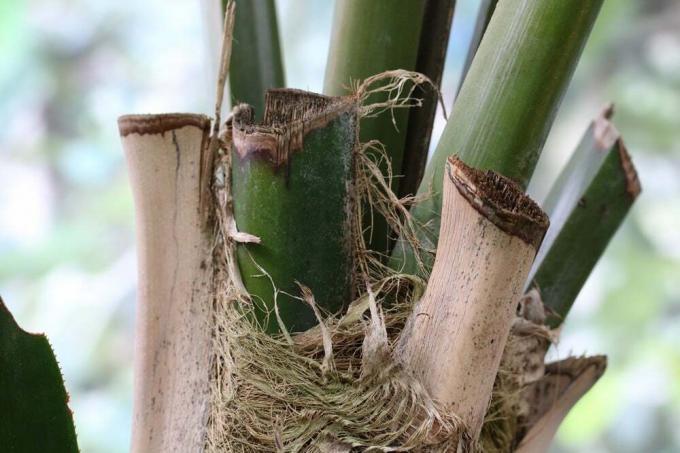
Due to its tropical origin, the Areca palm is used to high humidity in its location. Such high values do not normally prevail in domestic living spaces. The average humidity in the living rooms here is very low and decreases considerably during the long heating period in winter. If this value is consistently too low, the palm tree will thrive and grow even more slowly. Therefore, the dypsis lutescens must be helped in this area so that the plant can feel good in the long term. A slightly elevated coaster on which the palm tree is placed offers first aid after it has been filled with pebbles and water.
- Requires high humidity of 80-90% in location
- Spray palm daily with lukewarm water
- Use a spray bottle with a very fine mist
- Rainwater, still mineral water or lime-free tap water is ideal
- Place containers filled with water on radiators during the winter months
- Indoor fountains are also well suited
- Alternatively, a nebulizer can also help
Tip:
The cultivation of the gold leaf palm in hydro culture is optimal, since in this way the required humidity is created over a long period of time. The corresponding humidity can be easily measured in the respective room with a hygrometer.
Cut
The areca palm grows extremely slowly, so it rarely needs to be pruned. In addition, no special pruning measures are necessary to maintain the distinctive growth of the gold leaf palm. However, it makes sense to prune them in between, especially when a lot of withered leaves appear. In this case, however, the background to the withering should also be explored.
- Growth per year is only about 15-20 cm
- Regularly remove dead, yellow and dried leaves
- Cut these off close to the base
- Only use sharp and well disinfected cutting tools
- It is essential to avoid damaging bruises and injuries
repot
Since the growth of the Areca palm is very slow, the plant does not have to be repotted too often. This process is necessary at the latest when individual roots grow out through the plant substrate. If so, it's time to move to a larger planter. This should provide the palm with sufficient downward space, as it develops considerably long taproots over time. It is also important to have a sufficiently large drainage hole for excess irrigation water, which is located in the bottom of the pot. When repotting, a lot of tact is required, as the roots of the palm tree are very sensitive and react adversely to injuries. If the gold leaf palm has already developed a powerful growth habit, then another part of solid garden soil should be added to the substrate. In this way, the stability in the planter can be significantly increased.
- The ideal time to move is spring or summer
- Repot young specimens annually
- For older and larger specimens, this is only necessary every 2-3 years
- First put the palm tree in a water bath to pot it out better
- Then create drainage in the bucket
- Spread pebbles, perlite, or broken pottery over the drain hole
- Fill in the first layer of plant substrate
- Place the palm tree in the middle of the new container, then add more soil
- Press the plant substrate lightly in between to avoid cavities
- Maintain the pouring edge so that the water does not overflow
multiply

The areca palm can be propagated from seeds, sowing is possible all year round. However, a sufficiently warm temperature is necessary for germination. In addition, with this method, it takes a few years to grow a beautiful golden fruit palm. The plants can be propagated much easier and faster through their ground shoots. Older specimens only develop these bottom shoots under ideal site conditions. For propagation, these are simply separated and placed in a smaller planter. In this way, the next generation of the gold leaf palm grows up promptly. The following spring, the new areca palm can then move to a larger pot with special palm soil.
- Temperatures of 18-25° C are required for sowing
- Is tedious and dependent on the right conditions
- Alternatively, ground shoots can be separated from the mother plant in spring
- Ground shoots should be at least 30 cm tall
- Watch out for established roots
- Plant the bottom shoots individually in small pots
- The ideal substrate is compost mixed with some sand
- Keep the pots in a warm, bright place for a few weeks
- There must be no direct sunlight
- Water adequately but not excessively
- Do not fertilize for the first few months
Tip:
If a transparent plastic film is put over the planters, then sowing and planting will go better and faster. This method of growing requires making some small holes in the plastic wrap for ventilation.
Diseases & Pests
In itself, the Areca palm is quite robust and not so easily susceptible to diseases and pests. These appear mainly in winter, when it is too cool and the air in the room is too dry. But not only wrong site conditions weaken the immune system of the plant, mistakes in care also lead to it. The plant can react very sensitively to the pesticides from the specialist trade, so it is better to avoid using them.
- Check leaves regularly
- There are occasional spider mites, scale insects and mealybugs
- The red spider is also possible
- Fungal infections caused by sooty mold are less common
- In the event of an infestation, carefully rinse the pests off the plant
- Wipe leaves carefully with cloths soaked in alcohol
- Spraying with a fine mist of water helps preventively
 garden editorial
garden editorial I write about everything that interests me in my garden.
Learn more about palm trees
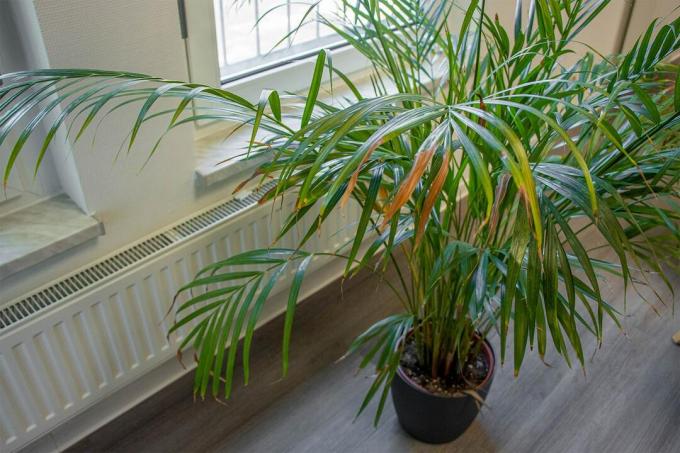
Palm leaves hanging: save yucca & co
Palm trees give the home a southern flair. However, if Yucca & Co. let their leaves droop, their sight is rather desolate. The causes of hanging palm fronds vary. A rescue attempt is always worthwhile.
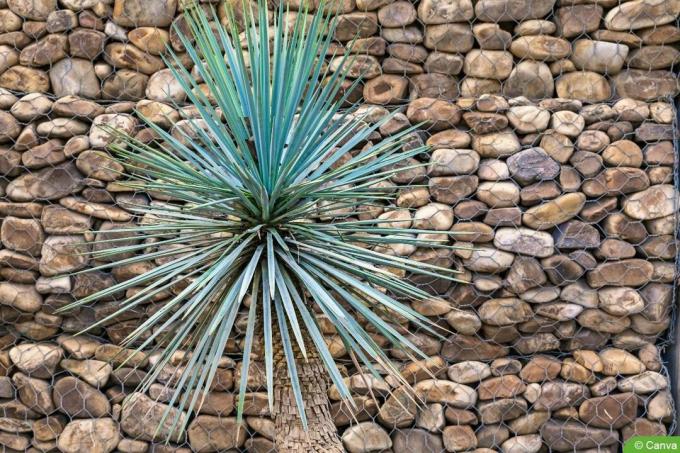
Blue palm lily, Yucca rostrata: 12 tips for care & Co.
The blue yucca (Yucca rostrata) is one of the most fascinating Yucca species. Since it hardly requires any care, it is also suitable for the office. Planted in the garden, it is considered hardy when it is dry.
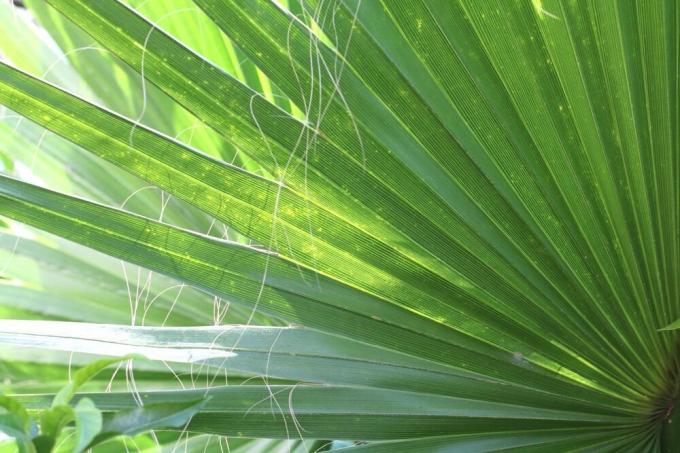
Washington Palm: Care From A-Z | Overwinter Washingtonia robusta
The Washington palm is a decorative plant that can grow to an impressive size. Due to the lack of winter hardiness, the plant is usually kept indoors in this country. When it comes to care, the palm makes certain demands so that healthy development can occur.
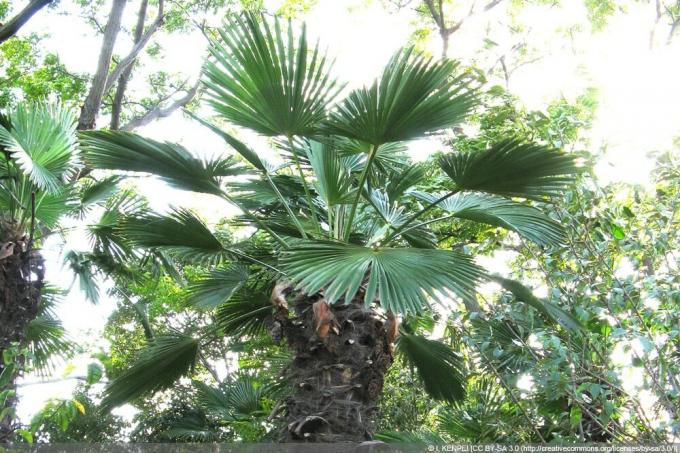
Wagner's hemp palm, Trachycarpus wagnerianus: Care from A-Z
If you want exotic flair in your garden or on your terrace, you can't avoid Wagner's hemp palm. No wonder: the extremely decorative umbrella palm not only looks impressive, but is also very robust. More about this is here.

Candle palm lily, Yucca Gloriosa – Care from A-Z | Is she hardy?
A yucca is better known to most as an exotic houseplant, the candle palm lily (bot. Yucca gloriosa) is also ideal as an outdoor plant, bringing a touch of tropical flair to your garden.

Golden fruit palm: is Chrysalidocarpus lutescens poisonous to cats?
The golden fruit palm is a popular houseplant that scores with its attractive appearance. However, many pet owners are unsure whether the plant could be toxic to cats. There is also a risk of confusion with other palm species that definitely have toxic properties.
